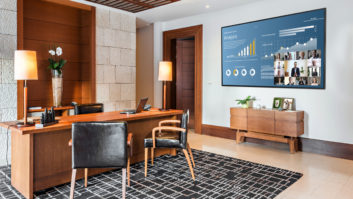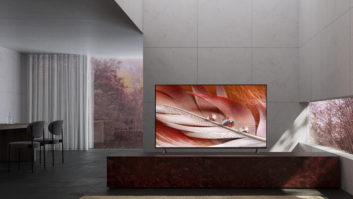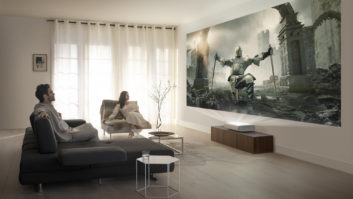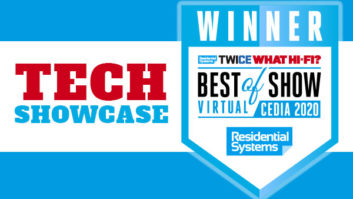This Integration Guide was sponsored by Lowell and Peerless-AV as a supplement to Residential Systems, November 2017.
The evolution of the television, from big-box sensation to trim viewing panel, has had a significant influence on everything from interior design to technology integration. In the custom installation universe, the television’s weight loss has shaped one of our niche markets in particular: racks, mounts, and enclosures.
With lighter televisions (and an increased demand for networked home entertainment) has come smaller components. Subsequently, racks, mounts, and enclosures, too, have moved away from their clunky roots to embrace lighter build materials and designs that acknowledge the shrinking of the electronic components they lift, support, and hide.

Middle Atlantic’s VDM mount
“The newer TV designs have definitely allowed us to use much more streamlined mounts,” said Mark Di Pietro, president of integration company, SoundVision. “What used to be big and bulky and tough for one person to install are now very manageable for one technician. It has allowed us the flexibility to, in many cases, use fewer resources than before. For example, we still might need help with the television because of the dimensions, but one person can be working elsewhere while another does the mount by themselves.”
Advances in technology have also influenced how manufacturers approach the design of their racks and mounts, where everything from aesthetics to how they will be most actively used is part of the research and development process.
“First, aesthetics is important. This is priority on the residential side and becoming increasingly important within the commercial market as well,” noted Timothy Troast, vice president of product management at Legrand Commercial AV, Middle Atlantic Products. “Simply fastening an HDBaseT extender with hook and loop to the back of a display won’t cut it. Wall boxes offer a cleaner, more reliable install. At the rack, a homeowner typically views aesthetics as quality, which translates into an organized rack layout with clean, well-managed, and properly labeled cables.”
Real estate also is valuable. “Space utilization within the mounting solution becomes increasingly complex as more non-rackmount devices are installed,” Troast added. “Creating layers of mounting utilization or moving to the open-air space makes the most of afforded real estate. This mounting versatility allows the installer to locate the devices in the best possible location to minimize cabling which, in turn, can improve system reliability.”
The decrease in space and increase in density compounds thermal management requirements, so the heat load of the system must be addressed. “If airflow is minimized, it can create system reliability and longevity issues,” Troast continued. “To that end, understanding best practice standards for both active and passively cooled AV enclosures will be increasingly valuable as AV technology evolves.”
Mounting Impact
Mount solutions have to take into consideration a number of factors before integrators can make the correct choice for their projects. Beyond holding up light but wide television screens, mounts that allow cable management, multiple viewing angles, and ideal component device placement are now standard for the industry.
At CEDIA 2017, where several television wall mounts options were on display, Future Automation picked up a CEDIA Award for its Heavy Duty Motorized Wall (HSE) articulating wall mount for screens between 70 and 110 inches Allowing rotation of screens, the HSE can move up to 90 degrees from a flat on-wall position and includes pre-set positions with control via infrared, contact closure, and RS232.
Middle Atlantic’s Proximity Series AV storage solution is an ideal choice to support decentralized systems such as media rooms and home theaters. Featuring in-wall box designed to fit both 16- and 24-inch stud bays, the Proximity also includes a sliding mounting plate for easy access to AV storage behind the display.
“Integrators can easily unhook the plate from the sliding mechanism to mount small devices onto the 15-by-10-inch mounting space and service them without having to remove the display,” Troast said. “The Sliding Mounting Plate is designed to mount directly on the wall behind the display. All Proximity solutions features Middle Atlantic’s patented, tool-free Lever Lock system to accommodate, conceal, and reliably mount a range of AV components.”
Behind the television, wall-mounted device storage is also a feature of HIDEit’s Uni-NSM vertical wall mount, which provides a solution for discreetly hiding mid-sized networking devices that typically fit into a 1U rack slot. Featuring a minimalist design, the Uni-NSM provides access to necessary ports while maintaining airflow that the company said is comparable to open-frame rack mounts. It has a load rating of 15 pounds.
Peerless-AV’s SmartMount and Designer Series of mounts were on display at CEDIA, with the company highlighting its SmartMount Universal Flat Wall Mount (SF670) and SmartMount Universal Tilt Wall Mount (ST670). The SF670, for installation of extra-large displays, features an ultra-slim profile and a wall plate that holds displays weighing up to 250 pounds, has junction box access ports and horizontal display adjustment up to 12 inches, while its glide brackets enable quick display-to-mount attachment thanks to its hook-on design. Similarly, the ST670 supports displays up to 250 pounds and includes auto-latching adaptor rails that secure displays without the use of a tool. A built-in kickstand holds the display away from the wall during cable routing, while its open wall plate provides cable management options. Horizontal and vertical adjustments allow end users to adjust viewing angles.

Peerless-AV’s SmartMount Universal Flat Wall Mount (SF670)
Though mounting televisions above fireplaces continues to be controversial, MantelMounts’ MM850 allows the viewer to control TV viewing positions through most popular home automation systems, such as Crestron, Control4, RTI, and Amazon Alexa. The MM850 also features wired, built-in Ethernet, simplifying setup for installers, as well as simplifying the process for customer to download software updates. The unit also includes a 433MHz RF remote control, which sets the vertical and horizontal TV position from anywhere in the room.
To allow use of the fireplace while watching television, the MM850 provides two safety features: a heat-sensing thermocouple mounted near the television that measures heat from a fireplace, and an automatic failsafe that automatically retracts the TV to a fully raised home position when the thermocouple detects an unsafe temperature for electronics.
“Some integrators, accustomed to working with high-end home automation projects, felt their clients wouldn’t want to pull the TV down themselves when everything else in the house was already automated through their home control system,” KC Bean, Mantelmount’s CEO said. “So it was imperative that we invented a solution for that group of TV install/home integration professionals.”
Racks and Enclosures
With many mounts also now coming with small rack spaces, rack design and enclosures have also had to redefine how space is used.
“Rack manufacturers need to keep an eye on emerging electronics, while continuing to provide support for legacy equipment,” noted Kevin Ditch, director of engineering for Lowell Manufacturing. “Although components have prompted some non-standard rack designs, such as the half-width rack, they’ve also influenced accessories for standard 19-inch racks, including shelves with quick-attachment areas or mounting points to accommodate non-rackmount equipment.”

Lowell’s LDR rack
Lowell’s LDR Rack Series, with beveled corners and tempered glass door, is a stand-alone design for home theater or office applications. An 18U–42U unit, the series The LDR features removable side panels and a rear access cover, front mounting rails providing 1.82 inches of equipment clearance even when the optional front door is added, knockout racks on the top and bottom, rubber feet, and side ventilation to allow passive heat dissipation.
VMP Mount Products’ new ERWEN-12E750 19-inch wall rack enclosure is an iteration of the company’s ERWEN-12E750 wall cabinet, and features 24 inches of usable depth. With a loading capacity of 120 pounds, the unit ships fully assembled with adjustable front and rear rails, vented bottom and top, cable routing knockouts in the top and bottom, and removable hinged tempered glass front door, locking side panels, and hinged back panel.
“This is a workhorse of a wall mounted rack enclosure with the added depth you need for installing today’s deeper components,” said Keith Fulmer, president of VMP in a statement. “With adjustable four-post rails, a removable hinged wall plate, reversible tempered glass front door, and optional fans for enhanced thermal management, the ERWEN-12E750 has all the features today’s professional installers are looking for.”
Mounting the Future
Troast invoked Moore’s law when discussing the evolution of mounting solutions in relation to technology. More than 50 years ago, Intel’s co-founder Gordon Moore observed that computing would dramatically increase in power and decrease in relative cost at an exponential pace. At modern rates that is every two years, though judging by recent layman observations that pace might have accelerated.
“The pace at which more devices and circuits are being introduced to the rack is astounding and requires us to look at the infrastructure solutions that are integral to meeting the needs of the integrator and the homeowner now and in the future,” Troast said. “The whole industry revolves around power and data, so Power over Ethernet (PoE) solutions continue to impact this category. For integrators, bringing them together on a single cable simplifies installation and increases reliability—especially when it reduces reliance on Wi-Fi devices. PoE will completely change how cable is managed and how power is distributed in the rack.”
For example, Troast pointed out, it can reduce or even eliminate wall warts, and PoE lighting solutions offer the potential of more switches and therefore more category cabling. “While artificial intelligence (AI) isn’t something that would normally come to mind when you think of sheet metal, advancements in sensor technology and monitoring capabilities opens the door to proactively managing the entire rack or enclosure ecosystem by leveraging the data collected to maximize uptime and improve homeowner satisfaction,” he explained.
For integrators, even though television mounts have evolved to make their jobs easier, some think that they might become unnecessary all together, though racks and enclosures will continue to aid in component storage and management.
“I think equipment mounts will become less and less necessary as the displays get lighter and thinner,” said Curtis Cole, managing partner at integration firm Systems Design Company. “Many TV manufacturers are already including mounts for some of their higher end specialty TVs like the Samsung Frame TV. Equipment racks will also continue to get smaller as AVB distribution becomes more prevalent. I think you will see a more distributed audio/video configuration rather than the predominately centralized configurations we currently install.”
Llanor Alleyne is a contributing editor to Residential Systems.







